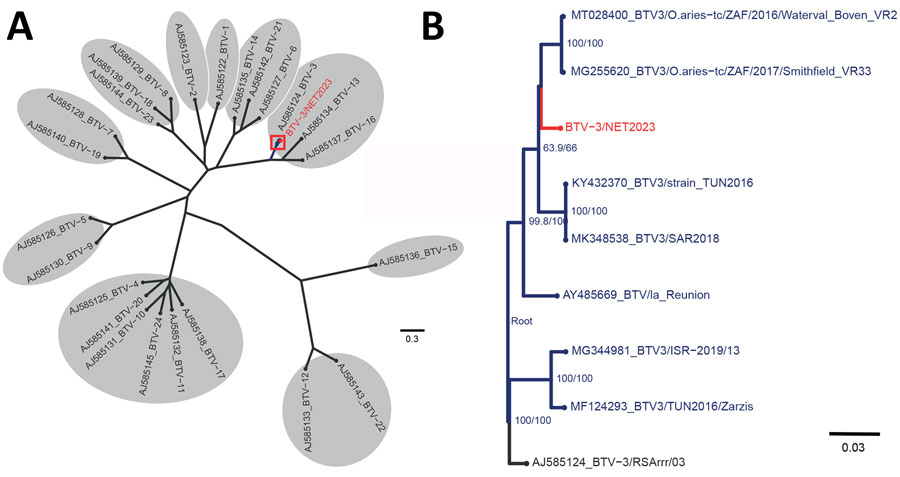Emergence of Bluetongue Virus Serotype 3, the Netherlands, September 2023
Melle Holwerda
1
, Inge M.G.A. Santman-Berends
1, Frank Harders, Marc Engelsma, Rianka P.M. Vloet, Eveline Dijkstra, Rene G.P. van Gennip, Maria H. Mars, Marcel Spierenburg, Lotte Roos, René van den Brom
1, and Piet A. van Rijn
1
Author affiliations: Wageningen Bioveterinary Research, Lelystad, the Netherlands (M. Holwerda, F. Harders, M. Engelsma, R.P.M. Vloet, R.G.P. van Gennip, P.A. van Rijn); Royal GD, Deventer, the Netherlands (I.M.G.A. Santman-Berends, E. Dijkstra, M.H. Mars, L. Roos, R. van den Brom); Netherlands Food and Consumer Product Safety Authority, Utrecht, the Netherlands (M. Spierenburg); North-West University, Potchefstroom, South Africa (P.A. van Rijn)
Main Article
Figure 2

Figure 2. Phylogenetic analysis of BTV-3 variant found in livestock in the Netherlands, September 2023. Trees were obtained by using the maximum-likelihood method. A) Initial phylogenetic comparison of genome segment 2 sequence of the emerging BTV-3/NET2023 variant from the Netherlands with segment 2 sequences from notifiable BTV reference strain serotypes 1–24. B) Available and closely related genome segment 2 sequences from different BTV-3 strains selected for detailed phylogenetic analysis. Unrooted tree branches have bootstrap values indicated at the nodes. GenBank accession numbers are included in sequence names. Scale bars indicate nucleotide substitutions per site. BTV, bluetongue virus; BTV-3, BTV serotype 3.
Main Article
Page created: June 13, 2024
Page updated: July 20, 2024
Page reviewed: July 20, 2024
The conclusions, findings, and opinions expressed by authors contributing to this journal do not necessarily reflect the official position of the U.S. Department of Health and Human Services, the Public Health Service, the Centers for Disease Control and Prevention, or the authors' affiliated institutions. Use of trade names is for identification only and does not imply endorsement by any of the groups named above.
